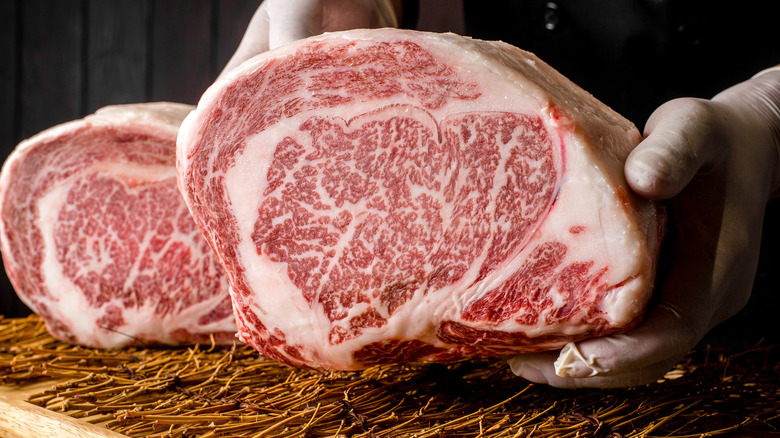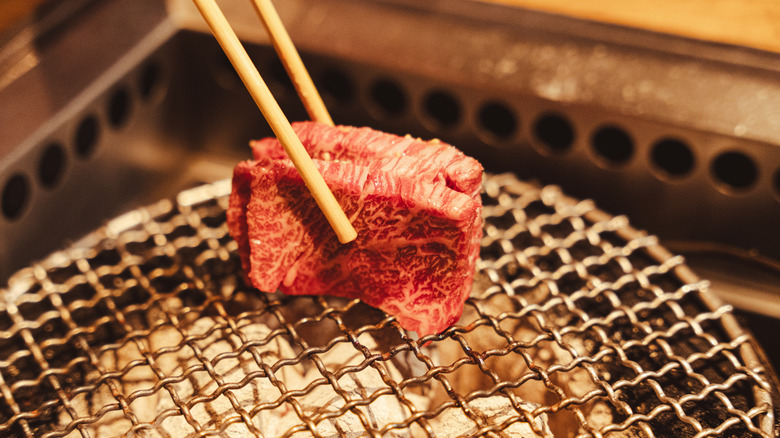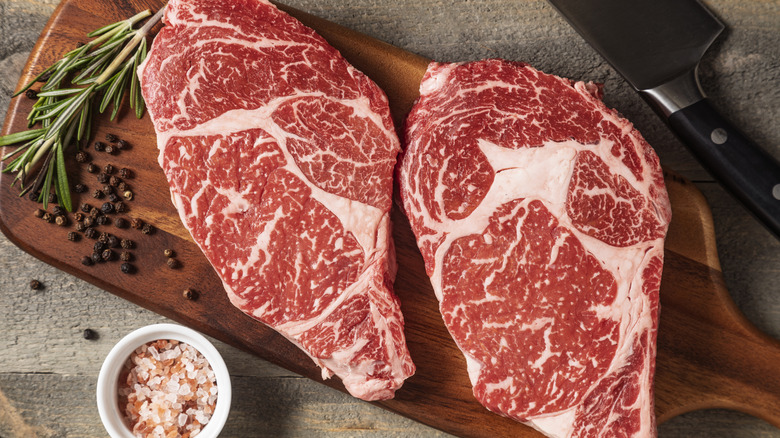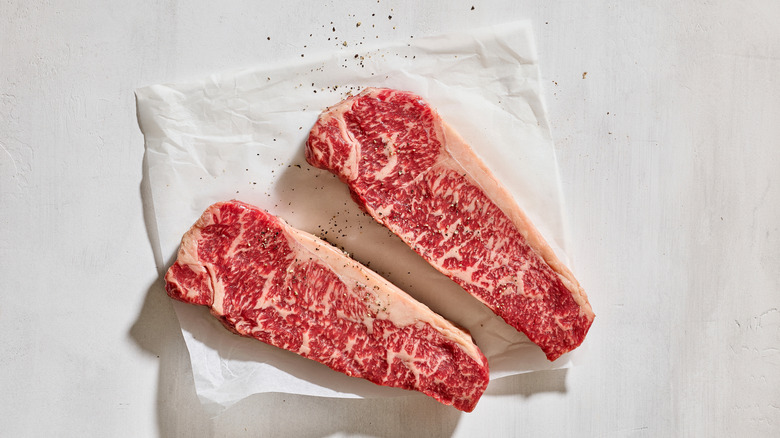American Vs Japanese Vs Australian Wagyu Beef: What's The Difference?
If you enjoy a great steak or just meat in general, you've probably heard of wagyu beef (and probably know why it's so expensive). Wagyu beef is produced from four specific breeds of Japanese cattle that are known for their intense marbling or intramuscular fat that gives the meat a uniquely rich, buttery taste and ultra-tender texture. The delicious taste and texture are the reasons why A5 wagyu steak is considered the height of luxury.
The production of wagyu beef originated in Japan in the 1860s, the result of Japanese cattle farmers crossing native Japanese breeds with imported breeds, resulting in the intensely marbled texture we've come to associate with wagyu beef. In 1975, production of wagyu beef expanded stateside, with the introduction of wagyu cattle, which were crossbred with North American breeds. Later, in 1988, Australian cattle farmers introduced Wagyu genetics, once again crossbreeding with local cattle breeds. This has resulted in different variations of wagyu beef: Japanese, Australian, and American.
To learn more about the different varieties of wagyu beef, Food Republic spoke to Golan Haiem, founder and CEO of Destination Wagyu. While the national variations are all wagyu, they're not the same. Haiem explained, "Japanese, American, and Australian Wagyu differ in key areas including genetics, breeding protocols, feeding duration, and grading systems. These distinctions have a measurable impact on marbling, flavor, and texture."
Japanese wagyu beef has the highest marbling
When asked about the differences between the national varieties, Golan Haiem explained that, as the original, Japanese wagyu is the most rigorously controlled. "Cattle are purebred, often raised for over 600 days on grain-intensive diets, and are graded using Japan's Beef Marbling Standard, which ranges from 1 to 12," said Haiem. He explained that the same scrutiny is applied to the lineage of the beef, including Kobe or Miyazaki, which are both regional varieties of wagyu beef.
In terms of taste and texture, "Japanese A5 Wagyu consistently delivers the highest marbling in the world," Haiem shared. He noted that this is due to Japanese wagyu having an exceptionally high concentration of intramuscular fat. As a result, Haiem said, Japanese wagyu beef has "a soft, almost custard-like texture with a mild, buttery flavor due to the beef's higher oleic acid content and low melting point." According to a 2023 study for the University of Seville in conjunction with the Seville North and Aljarafe Health District and the Costa del Sol Hospital, oleic acid may help in preventing cancer and Alzheimer's disease, as well as lowering cholesterol.
American wagyu beef has a strong beef flavor
Most American wagyu is genetically different from its Japanese counterpart, and usually consists of a cross between Japanese Wagyu cattle and a North American breed, like Angus cattle, Golan Haiem explained to us. However, there are a few thousand full-blooded Japanese wagyu cattle here in the States — but they are few and far between. The crossbred wagyu must be at least 50% wagyu to qualify. Whereas Japanese wagyu cattle are fed for just over a year and a half, he said that American feeding programs are typically much shorter, usually 300 to 400 days on average — though some producers feed their livestock for more than 400 days.
As a result, Haiem noted, "American Wagyu, with its Angus heritage, tends to offer less marbling but a more pronounced beef flavor. The texture is firmer, and the fat distribution is less uniform, making it better suited to larger cuts or Western-style cooking techniques." You could use it in a rosemary-rubbed rib-eye steak recipe or as a wagyu beef brisket.
Australian wagyu beef has something for everyone
When asked where Aussie-produced wagyu beef fits into the grand scheme of things, Golan Haiem said, "Australian Wagyu occupies a middle ground." Australian wagyu includes a larger mix of fullblood Japanese wagyu and cattle that's been crossbred with Australian varieties. "Feed periods range from 350 to 500 days, depending on the producer," Haiem said.
The mix of genetics and variation in feeding periods of Australian wagyu naturally affects its taste and texture. Haiem explained, "Depending on whether the cattle are fullblood or crossbred, marbling and flavor can vary widely." However, he noted, the top-tier Australian wagyu producers can achieve beef that scores high on the BMS (beef marbling scale), "making their Wagyu suitable for both fine dining and export at scale."
Whether you choose Japanese, American, or Australian wagyu, if you follow specific tips for cooking wagyu at home, you'll end up with flavorful beef that has a higher-than-average marbling content that's perfect for everything from gourmet beef fajitas to your favorite steak recipes.




